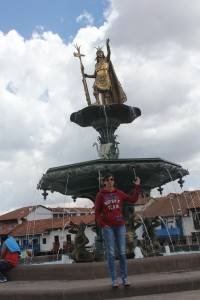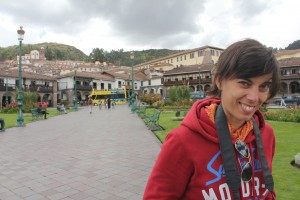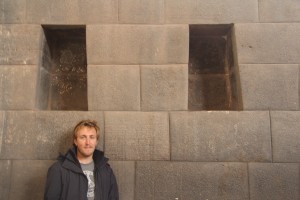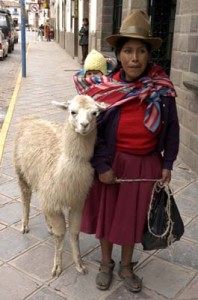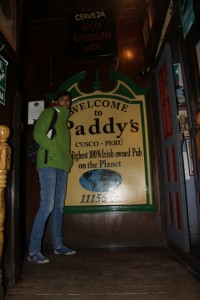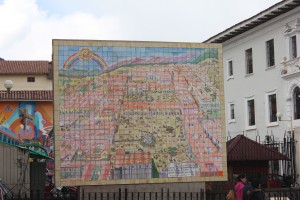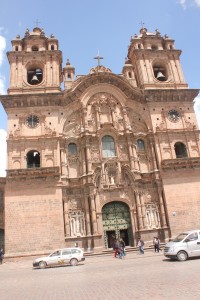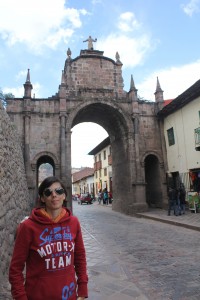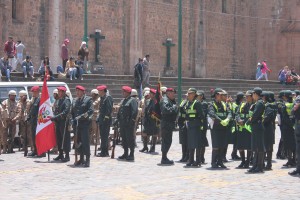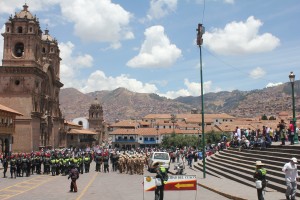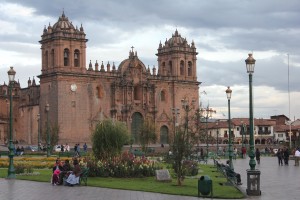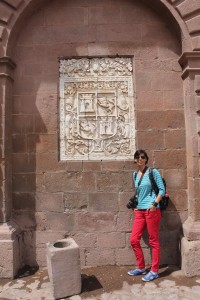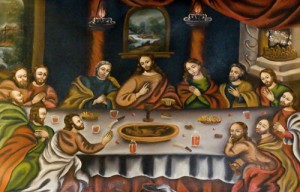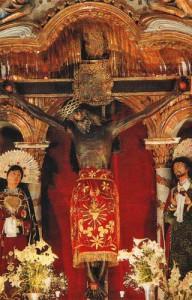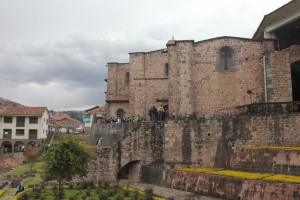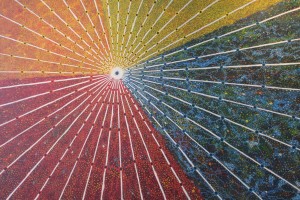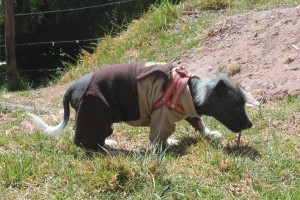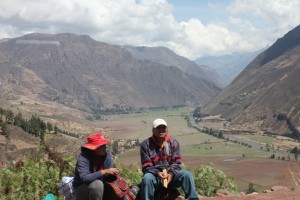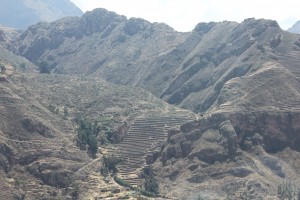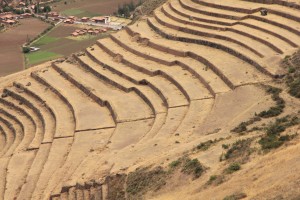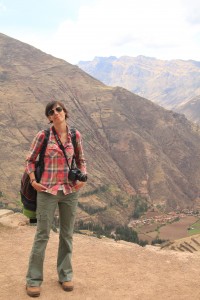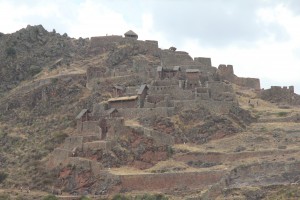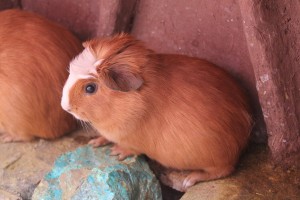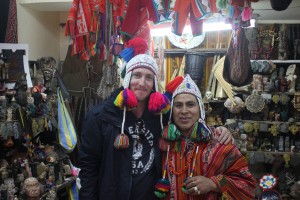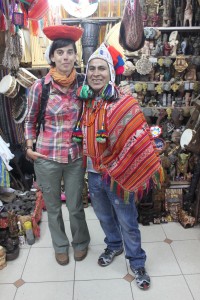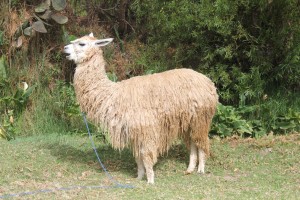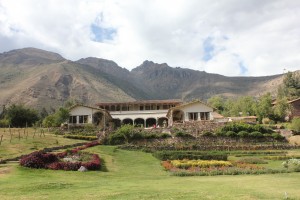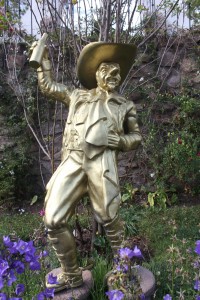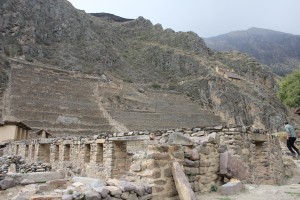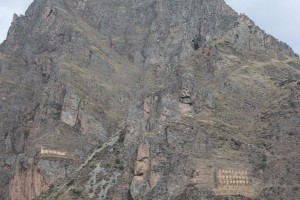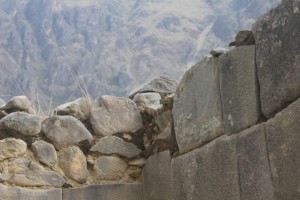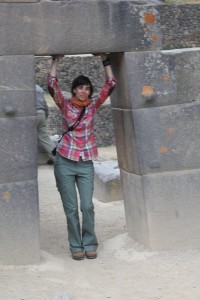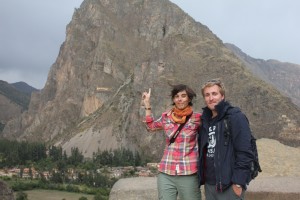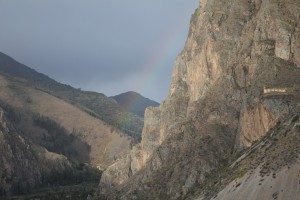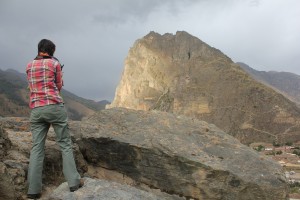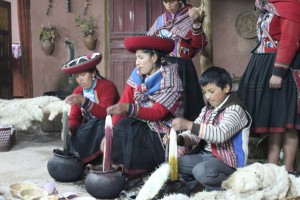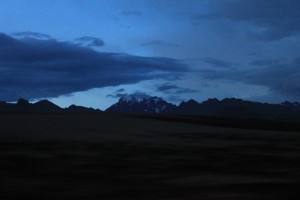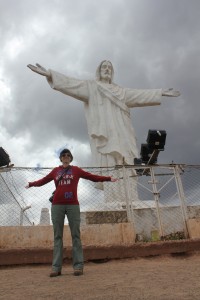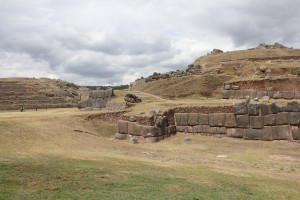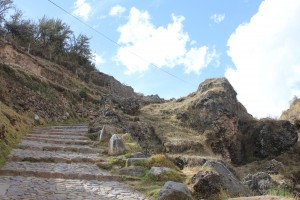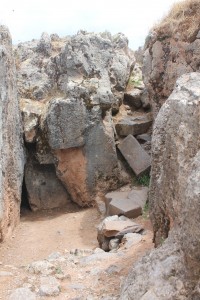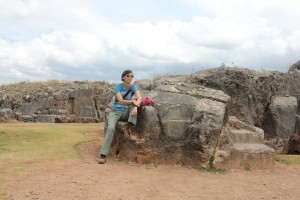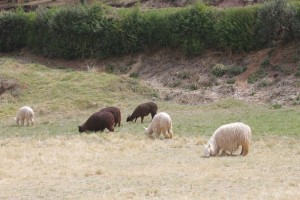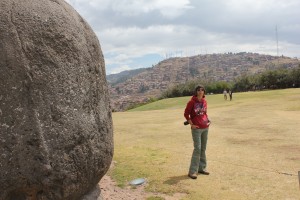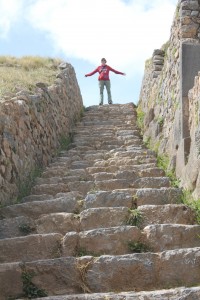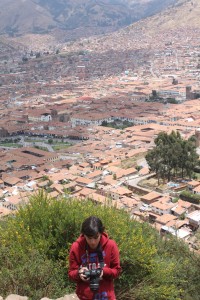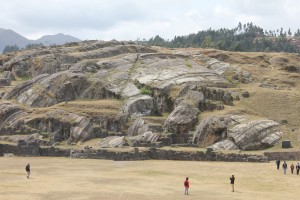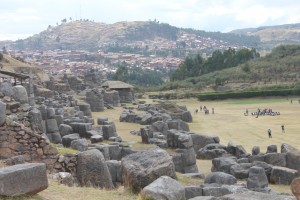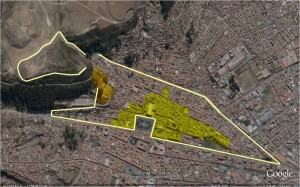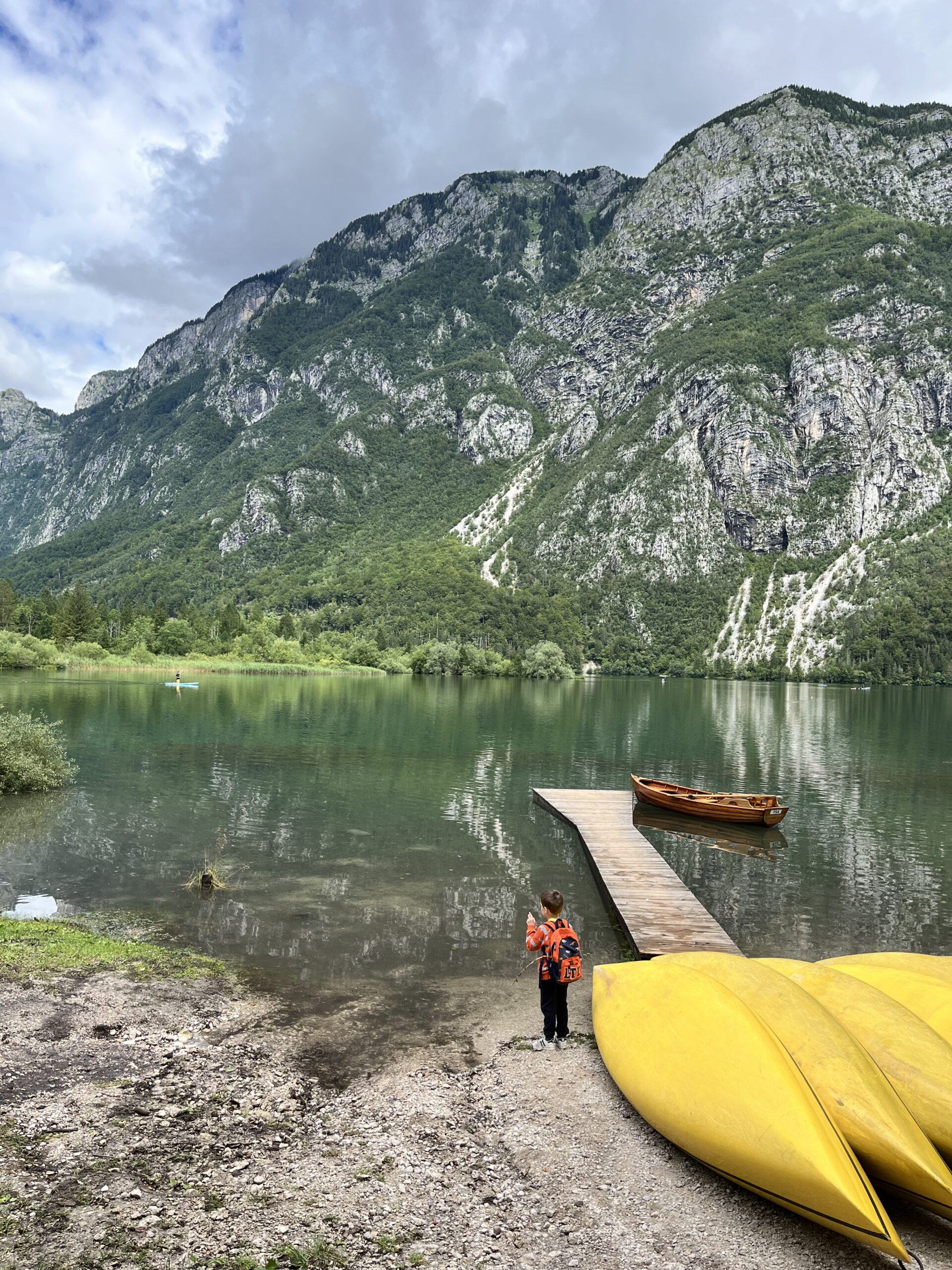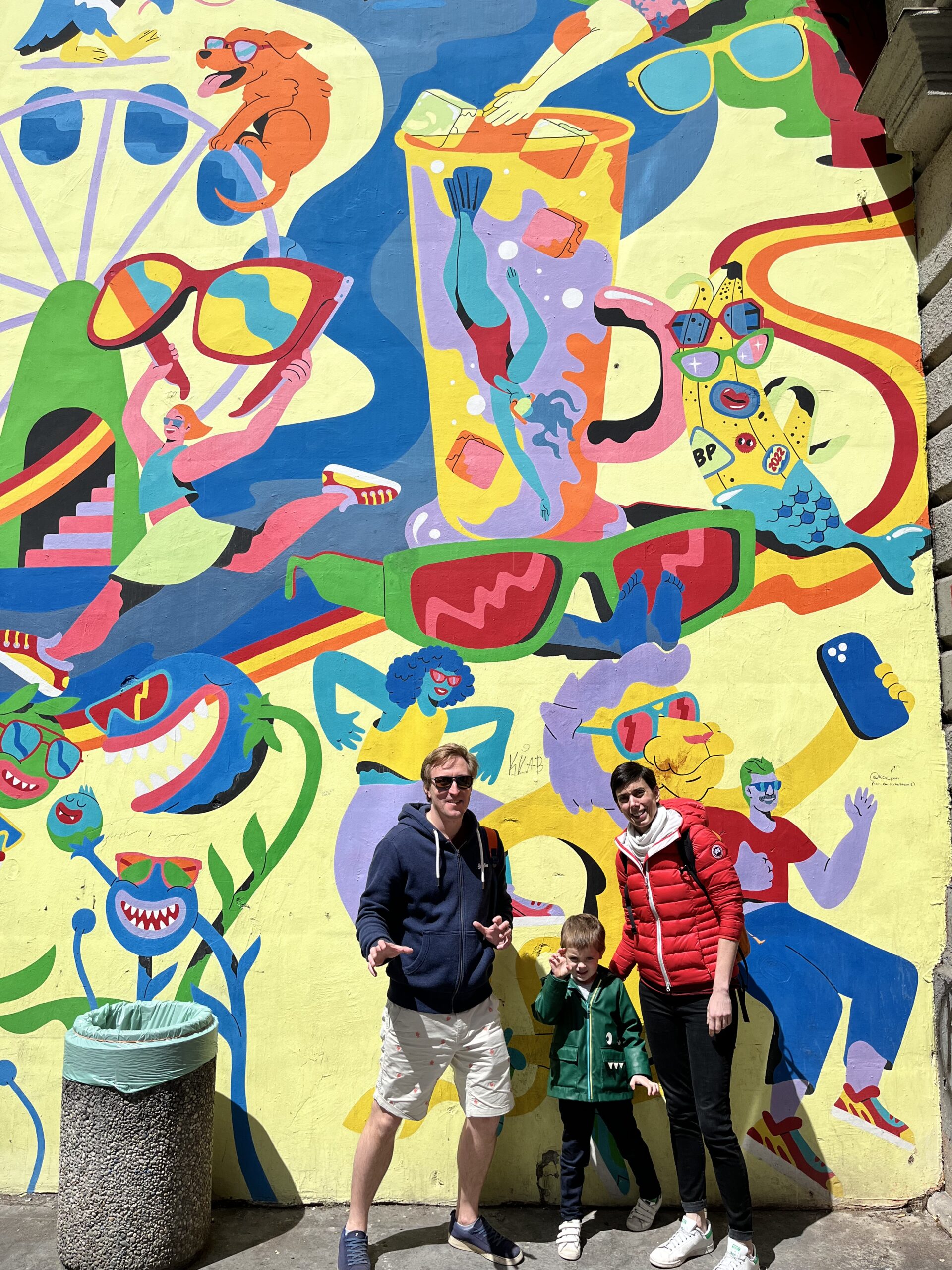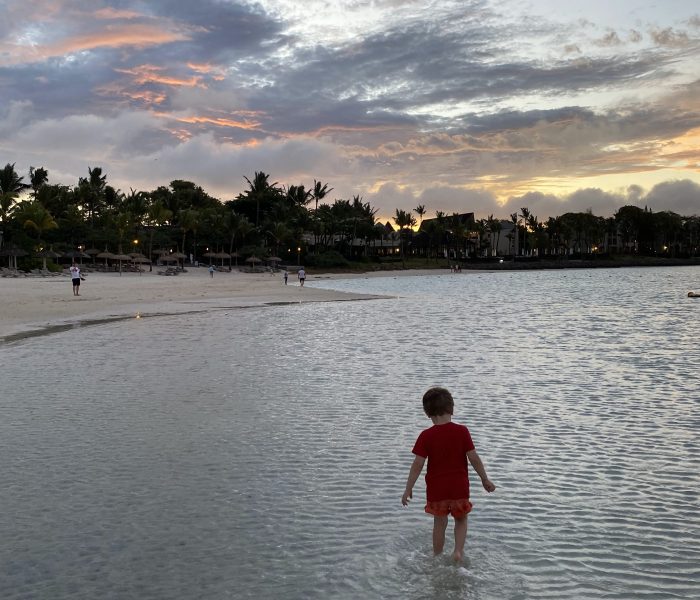Day 1 (Friday, 27th September 2013)
We woke up on Friday morning with a mission, the primary objective of the day was to obtain tickets for Machu Picchu and if possible the Inca Trail. After breakfast, which was simple but good. We proceeded to ask the hotel, they informed us that all tickets for Machu Picchu needed to go through government Machu Picchu website but having tried to book and pay for the tickets online seemed impossible, this was confirmed if you read other people’s comments about the website. Essentially it only works for Visa cards with 3D Secure (not all countries even have this) and even then it only works half the time. We were a bit disappointed in our travel books, which did not mention this anywhere.
The hotel was pretty happy to sell us a tour or package but we decided to go to the government office ourselves, which was only a 15-minute walk including a couple of walk-bys as the office is not indicated. After a slightly confusion situation around what ticket is for what, we managed to buy our tickets for Machu Picchu and Wayna Picchu for the coming Thursday and Friday. This meant that we had to change our itinerary – we were planning to leave Cusco on the Friday which meant we needed to cut a day from Lima as we did not want to change our dates to Brazil. It also meant that we would need to stay two nights in Aquas Clientes or otherwise known as Machu Picchu Pueblo (town). According to the reviews the town did not have a good reputation, however it was needed to be done as we wanted to ensure we saw as much as possible of Machu Picchu. In the end we booked the Machu Picchu ruins tour (which is mandatory), Machu Picchu (climbing the mountain) and the next day Wayna Picchu (the other smaller but steeper mountain).
After buying the tickets, we proceeded to explore the town. The town centre is not too big but there are many interesting sites to see, most of these are Spanish churches built in strategic places to demonstrate their might over the Incas including building them on top of existing Inca temples or sacred areas. In particular The town centre revolves around the Plaza de Armas which in English means the Square of Arms, in Spain the main square would typically be called the Plaza Mejor or Major / Main Square (there are maps in Peru which have this name), this is an adoption of the Inca’s name for the square which in the Inca’s time the square was the main town square for the warriors to congregate. As the Spanish arrived they transformed it into the main town square as well as most of the sacred site surrounding it, in particular the main town’s magnificent cathedral was built using the resources from the older temple which stood in the same spot.
While exploring the town we saw a small traders market which sold Peruvian arts and crafts, I was particular impressed. I was not sure if everything was cheap Chinese imports, even thou it said everything was handmade, but the goods seemed pretty original and authentic to me. Well at least it did not look like the typical tourist souvenirs rubbish that I really hate. Izaskun’s theory is that they are very colourful so we are just naturally attracted to them like moths to the light. Regardless we ended up buying some stuff, which was relatively cheap too, a contributing factor to the shopping spree.
After a long day of sightseeing and shopping we headed back to hotel to rest before we go out again for our dinner choice. We decided that as it was Friday night we should try to go out somewhere, well at least have a beer as we were still pretty affected by the altitude sickness.That night we moved to a restaurant that we were recommended called Organic Greens. Its claim to fame was that it was the only organic restaurant in town. The food was pretty good but personally I preferred the previous nights restaurant while Izaskun preferred this restaurant. The restaurant was surprisingly quiet for a Friday night, there was only two other tables occupied where one were finishing up when we arrived. At the end of the meal we were the only people left, at around 9pm which is not late even for South American standards.
After dinner we paid the bill and walked outside to find a pub to have a beer. After a minute or walk we found an Paddy’s, which claimed to be the highest Irish pub in the world, which actually turned out to be a rather authentic Irish pub. There were not many types of beers but they had the usual classics on tap and they served pint sizes which we was not too common in South America from what we saw. The pub was small but cozy with a work miniature train set along the top of the walls which passed through the two rooms every couple of minutes. It was actually pretty fun to watch. It seemed that this place was the place to go out in the area as it was pretty busy, much busier than the restaurant at least. We managed to grab the last free table, a spot of luck indeed.
I ordered two beers but due to my poor Spanish they gave me two pints but Izaskun had explicitly told me she only wanted a small beer (a bottle or half pint). Of course I was in trouble, for not listening or something like that “ I was not really paying attention ” In the end I told her that I would drink the other half which she ensured I did, after a pint I was really tired. I believe it was due to the altitude sickness combined with lack of sleep from the day before. I very rarely leave anything behind, a lesson from my parents especially regarding food, but drinking the next half pint was agonising something that Izaskun seemed to relish my struggling. Eventually we were too exhausted to stay so we walked home to sleep, really to prepare for a new day of being a tourist.
Day 2 (Saturday, 28th September 2013)
The next morning we woke up slightly later and headed to breakfast, just in time. Breakfast closed at 10am but most of the good food was not replenished from 9:30 which meant that there shortages of things such as coffee. Bacon was a particular luxury, it was hardly every available as it was really good and everyone seized the opportunity to grab as much as they can when it was made available, in addition when replenishing the bacon it seemed that the chef or staff were keeping the majority for themselves, maybe because it was really tasty, as the serving size was tiny. I recall that only 3 people got to eat the bacon before it was finished. The coffee was probably one the best coffees we had in South America, generally we disliked the coffee as it is more Americanised (in our humble opinion) which means that they had a lot of water and/or milk to it making it weak and un-tasty. This coffee was better but offered a strange after taste, additionally as we were not used to the stronger coffees now it meant that we needed to run to the toilet afterwards.
Anyway… after breakfast we headed to the Plaza de Armas, the place to be, to see some of the Spanish architecture. Around the Plaza de Armas there are two main churches (actually one is a church and one is a cathedral). We decided to take a look inside the church (Iglesia de la Compaña de Jesus), which is situated next door to the cathedral. We paid the entrance fee and declined to get a tour guide, we were not allowed to take any photos inside for unknown reasons. It was impressive inside especially with Peru’s largest alter, baroque facade and large dome. The church was built by the Jesuits in 1571 but reconstructed after a large earthquake in 1650.
It was intended to be the most magnificent church of Cusco but the story is that the archbishop at the time said it could not be as splendid as that of the cathedral which turned into a large debate, eventually involving the Pope (Pope Paul III). His view was that of the archbishop but this decision was only received towards the end of the construction, which was too late. Upon entering there are two large painting of an early marriage of Cusco, which show how the Spanish viewed themselves at the time, most of the paintings of Spanish show themselves in a superior authority to those of the locals. In addition all Angels in Spanish art wear Spanish armour and are always white. This of course was to demonstrate to the recently conquered locals that they were indeed in control of the Spanish now.After the church we headed slightly down the road to El Sol, which is the main street leading up to the plaza. This street is meant to be the main commercial street which boats many stores and banks. It also has another church which we planned to see later in the week, called Convento Santo Domingo. We also walked across town to the other side of town to an area called Santa Clara, of course on the way there at least two main churches which are Santa Clara and San Francisco.
At the end of the street of Santa Clara is a market, in particularly a general market which means less of the tourist focused Peruvian arts and crafts but more authentic items from food to home supplies and other essentials for locals. The market is called San Pedro and is housed under a simple glass and steel structure. The market consists of a series of narrow alleys, much like a flea market (it reminded me of Bruma Flea Market in Johannesburg for those of you who have been there). The ideas that impressed us the most was the food, not because it was particularly appetising but mainly as it consisted of much food that we had never seen before. In particular blue corn, speaking of corn. All the corn there was huge each ear of coin was about the size of small coin. In addition they seem to fry these ears of corn, but they do not pop like popcorn, for a tasty snack. I really liked them, simple but good. The market also had other types of food that we did not recognise at all, which must have been processed from some other vegetables.
After all that exploring we were tired and were looking to get back for some rest. Our altitude sickness was much better and we finally feeling stronger to walk around for longer times. Along the way home we saw some more markets, which is when we realised that these goods much be mass-produced somewhere as they were many items that were identical to the previous day’s items, however we did manage to buy a carpet for our house. The main requirement for it was that it had to be long and narrow for the corridor and it had to have at least one llama. We are please to say that it has many llamas on it.
That evening we decided to go a restaurant nearby to the hotel. We were hoping that it would be less touristy, and hence cheaper too. We walked about 2 minutes down the road and found a small restaurant and ordered a pizza and a juice, unfortunately they had run out of the local “blue corn juice” called Chichi. The food was good, overall we were impressed with serving and food standards in Peru, and the bill was way less than the other restaurants that we had been to the previous nights.
Day 3 (Sunday, 29th September 2013)
We woke up and followed our usual schedule for getting up and about. Today’s plan was to visit the outstanding architectural landmarks of Cusco namely cathedrals.
We headed down the Cathedral of Santo Domingo Cathedral or simply named La Cathedral. This is the one opposite the church that had visited on Saturday (Iglesia de la Compaña de Jesus). So we headed to plaza but there appeared to be some sort of parade around. There military outfits showing off as well as school children dressed up and parading the square. We stood and watched for a while.
There was some confusion as to what time they were to open, I understood from reading the guidebooks that they were to open at 11pm but it was not open. We thought we could walk to the other cathedral, Santa Domingo, while we waited for this cathedral to open. After a short walk we arrived but it too was closed. We were starting to wonder if were going to open at all but then again being Sunday they should. It was still around 11am so we had refreshments and waited patiently for the places to open. When we returned to La Cathedral it was surrounded by hordes of tourists, at least it was open now. We proceeded into the cathedral which was completed in 1654 after 100 years of construction and in 1983 became a UNESCO listed site. The original site of the cathedral was an Inca temple called Kiswarkancha, which was built about 100 years before the Spanish arrival. The temple also consisted of a palace for the ruler to stay, however the complex from de-constructed to make way and recycled into the current cathedral. The other materials used for the cathedral came from Saqsaywaman, an ancient Inca fortress located one the hills above Cusco. The exterior fasade demonstrates a barque style while inside demonstrates renaissance style.
As we entered we could see that the cathedral is divided into three sections or “sub-churches” if you will. The first sub-church was the most basic of the three but still boasted a dome and a very flashy gold baroque alter which consisted of many figures, it appeared to me to be an old version of a comic describing the saint super heroes and their achievements. The next sub-church was the largest and most impressive. The hall was huge, definitely larger than what you think from the outside. It was a bit different to other cathedrals I’ve seen before, there were chapels running entirely along the circumference, not strange I know but in the centre was the choir hall and organ which was only accessible from the front (i.e. from the altar). The choir hall was impressive it was entirely wood and all the seats and intricate details were carved. There was even some Inca influence in the carvings on the seats with local monsters. The main altar was entirely made of silver but honestly was not as impressive as the Jesuit version, but perhaps that is because the hall was larger which meant it did not have as much prominence. Behind the altar was actually another altar, which was entirely wood. It was the original altar until they brought the silver altar but they had never bothered to remove the older alter, instead they simply placed the new one in front of it. Above all this is a larger dome which is only supported by 14 pillars.
The main highlights of the cathedral for us were the “local version of the last supper”, a painting of the last supper adapted to the locals where instead of bread they eat roasted guinea pig and instead of wine they drink Chichi. The other highlight was the so called “Black Jesus Christ”, a figure of Jesus Christ on the cross but with black skin. We overheard from a tour guide that this was intentional from when it was made but having read the guidebooks and internet it states it was dyed from centuries of candle smoke. Regardless what the truth is around this, it is considered a sacred artefact and paraded once a year around the town in commemoration for the large 1650 earthquake.
The large sub-church was the least impressive but I believe this is because it is renovation and appears to be a place to dump the remaining saintly figures for other items that need restoring or do not have a place to go. There is a small crypt and a small shop to get your souvenir fix.
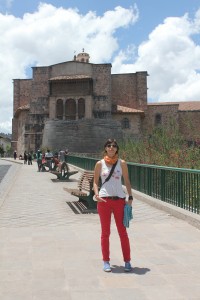
Outside the Convent Santa Domingo, the black stone is the original wall while the building on top was installed by the Spanish
After the Cathedral it was time to go see the other Cathedral, Convent of Santo Domingo, well technically it was a convent. It was only a few minutes walk away and much like the first cathedral this too was built recycling previous Inca buildings. The convent is built on top of Qurikancha, which I understand to be dedicated to the sun God, Inti. It apparently consisted of walls and floors entirely covered in sheets of solid gold which of course were removed. From the outside it is more apparent that the convent was simply built on top, there are two types of stones used, the blacker wall were the original temple walls while the convent on top is of course the new construction. From browsing inside it seemed to be more apparent that this convent was a somewhat hybrid with the other building there were many Inca items inside such as diagrams around the farming sessions and star consolations.
The rest of the afternoon we explored the area a bit further walking down the small streets but as it was Sunday it was quiet and deserted. We even walked into a tour agency to ask some questions who informed us that as it is Sunday they will not be able to help us, not sure why they were open then.
After a long day we had a quiet dinner and prepared for the tour that we had recently organised through the hotel. We had to wake up early for our tour for the sacred valley.
Day 4 (Monday, 30th September 2013)
Monday started with an earlier start, we were looking forward to seeing some of Peru’s most famous landmarks and sights. We prepared and waited outside for the tour bus to collect us, it was about 20 minutes. The bus was already full, the tour guide informed us that we were to be transformed to another bus once we arrive at the town centre, no problem for us as it appeared that most people on the bus knew each other already so it was probably better to go with a group where we would be able to meet some new people.
We ended up swapping for another van with a group of French and a couple of Americans and Australians, there were 12 in total, including us The French group only 2 of the 6 could speak English which meant that everything the tour guide said they would have to translate into French. It was a bit annoying to sitting next to the lady blabbing and having a separate conversation to the others while the tour guide spoke but then again I did feel back that they wouldn’t be able to understand what’s going. I suppose it was one of those necessary evils. The tour left the windy roads up through the mountains, our first stop was definitive tourist trap. We were dropped at a semi-circle building with absolutely nothing around it except for a market inside the building, we were told we would wait there for 30 minutes before continuing. We were not particular impressed as we were more interested in exploring some ruins or at least to see how people live in a village or town but instead were shipped to a market with nothing else to see.
Probably the most interesting thing that were saw was some locals with the llamas and a dog which we considered to be pretty ugly, but it was so ugly that it was actually cute. It even had a little coat. After serving our time we got back in the car and headed with the tour.
The next stop was along the top of the mountains overlooking a valley and a river cutting through it. We were told this was the origins of the Amazon river which actually starts from the mountains of Peru, it is ultimately created from the snowy ice caps peaking these mountains.The tour guide also explained and showed us the various types of crops grown in the area by the Incas, it was an impressive list with many types of grain I was definitely not expecting to have being grown so high in the mountains.
Afterwards we travelled a while to a small town called Pisac, it had been recently damaged by a flood in 2010 which the tour guide was pretty devastating to the town, which is only starting to recover from now, however above the town on the mountain slope is what is the real attraction is, Inca Pisac is an ancient Inca settlement. Of course, our trip wouldn’t be complete with some sort of confusion or drama. Ours came in the form of that everyone had their entrance ticket (a single ticket for all attractions in the Sacred Valley) except us. We were told our tour included it but the tour guide didn’t have ours which meant we had to pay at the toll. This wouldn’t have been a big deal but again it was annoying to have this uncertainity and lack of trust in what people tell. We were lucky that we brought some money – in particular Soles instead of US Dollars which is generally preferred. So after we bought the ticket we were a bit annoyed especially it always seemed that we are the only ones who get messed around. So after the ticket incident we arrived at the Inca Pisac site. It consists of a series of large steps moving all the way up the mountain, these steps were used for agriculture which many of which are still used today. The tour guide explained what the various buildings were but many of them have a suspected use or are simply unknown.
An issue with tracing the Inca’s history is that it was never written down so when the Spanish arrived and forced the locals to convert to Christianity and adopt Spanish as their language many people forgot or weren’t taught what the Inca history was. Today it remains mainly unknown what the Inca culture or even their history was. Much of the Inca’s history was actually written in the 16th century by Spanish writers who made an attempt to capture it but mistakes were made, for example the word ‘Andes’ was used by the locals to describe their enemy (a tribe called Andes) who lived in the rain forest past the mountains, however when the locals said ‘Andes’ and pointed to the mountains the Spanish understood they were telling them the name of the mountain range, which is why to this today the mountain range is still called the Andes.
After our brief exploration of the Inca Pisac we were transported to Pisac, a small town below the ruins. Again, it was pretty much a tourist trap. We were shown a small shop which sold Empanadas and roasted guinea pig. The cruel thing is that the live guinea pigs are kept next to the oven, about 2 metres away. I’m pretty sure they know what will happen to them. Poor guys, they look so cute. We tried some Chichi and an Empanada which was quite different but very tasty. Literally next door was a silversmith where they showed us how they made traditional Peruvian silver. It was a bit dry, the speech that is but still pretty interesting. We actually ended up buying something small which was expensive in Peruvian standards but still very cheap for European standards.
After our silver and Empanada talks we were told that we could speak to a traditional shaman, we were pretty tired of shopping so we were very keen to see what it would be like. We were escorted to a small store where the man quickly changed clothes to something more traditional. He proceeded by giving us hats, I had a cool Peruvian hat but women have to wear a different type that looks more like a big plate. Afterwards, he shared a strange liquid which we were to rub on our hands and inhale the fumes three times. It was strong but not overwhelming. It apparently had a mixture of plants, including mint as well as snake oil. The fumes did make us feel a bit light headed, so generally good stuff. He then proceeded burn some roots, which we again we needed to inhale. This was to apparently cleanse us (not sure what it was meant to clean). He chanted a bit which neither of us understood at all. After a minute or two it was done, we had been cleansed and blessed with some form of good luck charm.
After the ‘ceremony’ we managed to have an interesting chat with him around his profession and how it is changing. He informed us that it is a dying practise as most people don’t believe in it anymore. We thought to give him some money but thought it would nice to ask him what we should take as a good luck charm. He gave us a small stone that was magnetised, it is apparantly a spirital stone that we should keep in our backpack while we travel. In the end we paid him some money and headed out – just in time too as the rest of our tour group had caught up with us and were also interested in getting cleansed.
After a brief wait for the rest of the group we headed out, this time for lunch but quickly on the way we saw an interesting statue of an Inca god, I cannot remember which one. Essentially it was symbolic of the three phases of life, ‘heaven’, present and ‘hell’ where each of these were represented by an animal: Condor (heaven), Puma (present) and the snake (hell). The statue that we saw consisted somewhat of a man but included all three animal attributes.
So, moving onto lunch. The lunch system was a bit strange for us, essentially the issue is that a single group is arranged by different agencies. Each agency has their own lunch arrangement with different partners. This means that our group was split into three, and each of groups had to be dropped off at different locations and will eat a different lunch. We were in the last lunch group, so we waited for first the Americans to be dropped off followed then by the Australians. We were to eat with the French people along with the tour guide. As we arrived there were a couple of parrots, I suppose they were more attraction than anything else as they were definitely had a lot of attention from the coming and going crowds.
The venue was actually an old Spanish colonial home whose owners kicked out by the Sendero Luminoso (Shining Path), which is entirely another blog post, who saw the Europeans as cause of many of the current issues. The house must of been pretty luxurious for its time, it is situated between the main road and the river with a slope leading down. The premises is perfect for a resturant due to its large patio and view looking down the slope and river, as well as the surrounding mountains. It even had some domestic animals, in addition to the parents, mainly ducks and llamas.
The lunch was actually a buffet, the food was included but not the drinks. We feeling cheap so we didn’t buy any drinks at the place which was an intentional rip off, we figured we will simply buy water at the next town which will be 1 Sole instead of the 5 that they wanted here. Luckily for us the food was included in our tour which turned out to be pretty good. The highlisghts were Alpaca meat, Cerviche and Chichi jelly for dessert. Unfortunately for the French group discovered that they had to pay and additional 40 Soles person, which is a lot in local standards (for example a dinner for Izaskun and I both usually comes up to around that amount without alcohol). The French people were very grumpy, we were shamely happy that for once we weren’t the ones being messed around and felt a bit reassured that we were so disorganised or un-knowledable. The French group paid but to ensure that the tour guide suffered they intentionally took their time and ensured that departed later than we had planned. The rest of the group were getting grumpy, who the driver had gone to collect while we ate, which was understandable. In the end we were delayed about 30 minutes, the driver was getting impatient as I suppose he wanted to finish the tour as soon as possible and we still had to get to Ollantaytambo, our next stop.
It took around an hour to arrive to Ollantaytambo, which according to my guidebook is the best example of a typical Inca town as it wasn’t plundered much. It’s name originates from two words ‘Tambo’ means a place to rest, but not all towns are tambos they could be simple clearings on the mountains where people stop to rest before continuing. The ‘Ollantay’ is named after a famous general, the story goes along the lines that Ollantay fell in love with the Inca’s daughter which was strictly forbidden andwas punishable by death. In one ending the Inca decided to let live and let him marry his daughter where they lived happily every after but in the other the Inca has him put to death but the daughter and general find each other in the afterlife.
Ollantaytambo served as the last fortress against the Spanish conquest of Peru, after the conquest of Cusco it was apparently the location where the remaining empire congregated to retaliated which had a few successful battles but ultimately it was conquered and fell into disrepair, it was only until the 19th century that there was renewed interested in the town mainly attracting explorers from overseas.
Side Note: The word Inca originally only referred to the emperor or ruler but as the Spanish arrived it became more popular to refer to the general population as Incas or people who follow the Inca.
Overall the town is impressive, the entrance into town sits on a narrow road going up into the mountain. The town was definitely not designed for modern cars, as the traffic is horrible. We sat in traffic for about 30 minutes to get in and an hour to get out (due to a bus parking in the middle of the only road to take a phone call). Despite the traffic it demonstrated an impressive architectural skill and engineering, for example all the streets have running fresh water running down in gutters serving as a source of fresh water and probably sewage.
Upon arrival to the ruins appears daunting due to the steep steps that we will need to climb to see the temple of the sun, on the top. We first perform a stroll around the town which it was clear that used to be housing. On the other side, on the next mountain were a couple of buildings which served as granary. Apparently they were designed with multiple doorways to allow the cool mountain air to keep the goods fresh. The food stuff was stored in layers with mint which deter such pests such as mice.
After a short hike up the mountain slope, in the drizzlingly rain, lead to an open clearing where the stones were larger, essentially the higher you were on the mountain the higher your role would be in society which meant that the upper levels had better materials and mostly consisted of the religious priests or shamans. The stone was transported from over 7 miles up and down mountains, it still remains a mystery how they managed to do this. Simply crazy!
The final port of call was to visit a place called Chinchero which specialised in Peruvian wool, it is apparently a different technique than that of the rest of the country that has a reputation for being superior. We were due to drive back which would probably take us around 2 hours, after sitting in traffic for a while. Upon arriving to Chincero it was cooler than what Cusco would have been this was because it is even higher Cusco at 3,762 m. We were presented with a demonstration on how the local weaving is performed, the lady didn’t speak English too well but the talk was really interesting.
Essentially all the ingredients used are natural using different roots to clean the wool (there was a weird root that once grated and mixed with water created something much like soap) and colour, by combing different colours together they great others with impressive consistency and brightness. Overall it was interesting but at the end it was clear they wanted us to buy something, we didn’t fall for it this time. We were tired from the long day but also of the constant tourist traps that we were being sent to. It was strange to pay for a tour to take us to markets.
The drive back was quiet due to everyone being tired but also as the views of the sunset were spectacular, there was clash of colours mixed with the snow topped mountains. The drive was pretty uneventful and but the time we arrived home we were practically ready for bed. It gets dark early in Cusco, and it sets fast, which means it often seems later than what it was. By the time it was 8pm in Cusco, the time we arrived back, we were thinking it was close to 11pm. After being dropped off at the Plaza de Arms we said goodbye to everyone and headed back home, we had some food and took it easy for tomorrow we had decided we were going to do some hiking up the mountains.
Day 5 (Tuesday, 1st October 2013)
Our last day in Cusco before our trip to Machu Picchu was intended to be both training and a test of our fitness levels which we didn’t have much confidence in. We were to climb up the mountain of Cusco to the white Jesus Christ figure that resides on the top. The Christ figure is much like of Rio de Janeiro but smaller. We headed for breakfast and fought for some bacon, we speculated this would be the last ok breakfast for a few days so we might as well enjoy it. Again it was hard to get more than a couple of pieces, the hotel had seemed to filled up a bit more which meant more competition for the good food.
After breakfast we immediately went to start our assent up, there was a conveniently placed path near our hotel which went straight up which comprised of stairs and more stairs. It turned out to be a hard slog of a climb as the stairs were steep and never-ending, so far we were not doing too well on our test. After about 30 minutes of climbing we reached a fork in the path which didn’t make much different as they ended up at the same place, we decided to take the left path. Upon turning there was a mother with her two children struggling up, she told us to turn around. “Why?” we asked, she told us about a crazy dog sitting on the step. I was a bit confused, a crazy dog. It reminded me of an an incident when I was young when I was told to go further due to a dangerous snake but I decided that snake would be cool to see. The so called dangerous snake turned out to be a weird old naked man sitting the bush. I wondered whether this crazy dog could be something like that incident but stepping extra step or two I saw the dog. It looked out but we decided to wait and see what it would do, nothing. However as we were waiting a drunk man came stumbling behind the dog, who climbed the steep stairs effortlessly, the time now was around 11am – pretty early to be so wasted.
We decided to go back down and climb the other path and go around them, we were not in the mood for anything dodgy to happen to us. So with some grumbling we had to go down and go back up. Eventually we made it to the top and proceeded the short distance to the Christ figure. Along the side of the figure was a path leading down to some impressive ruins, these ruins turned out to be Saksaywaman which we didn’t know at the time. The ruins are actually known by many names, including: Saksaywaman, Sasawaman, Saksawaman, Sasaywaman, Saqsaywamanor Saksaq Waman or in Spanish as: Sacsayhuamán, Sacsayhuaman, Sacsahuaman, Saxahuaman. Pretty crazy, again which is due to a lack of written Inca language (known as Quechua).
Upon climbing down we noticed that it these ruins were not free, we feeling cheap we decided to walk around and see if we could get in another way as the complex large and pretty much situated around a field. We walked around for a while and found some more ruins on the outskirts of the main complex. It felt so very much unexplored and adventurous which it clearly wasn’t but mainly because there was no-one in sight and the ruins were not closed off or covered felt like they were very much unexplored. It made me think how the early explorers must of felt when first discovering these sights for the first time.
After several hours exploring we decided it was time to enter the complex, we slipped through some trees on the north side of the complex, walked past a llama herder (are the also called shepherds or something like a “llamaherds”?), he didn’t seem to mind that we were walking into the complex. After walking through the fields we had arrived at the complex. It was essentially divided into two sections, the right section overlooked the city while the other seemed to be more of a tower. We explored the city side first climbing up more steep stairs, something that we discovered on the trip was that Inca’s loved stairs, steep stairs in particular. The top had a plateau with some good views over the city.
The other section didn’t have as impressive views of the city but it did have good views of the local fields which many of which were used for llama herds. Upon climbing we encountered a lady really struggling to make it up the stairs, I actually thought she was going to get a heart attack. After finishing the stairs she collapsed luckily her husband was there help as I think we would have had to probably ask if she is dying, but luckily she seemed to recovered after a few minutes.
Later that evening we discovered that a theory for the complex was that it was to situated to be the head of a puma, for you see the entire town of Cusco was planned to be shaped to be a puma which was symbolic of the present or the living plain of existence. The complex situated on the mountain was the head that needed to be controlling or aware of the town. An interesting theory whether it is true or not.
After our exploring ways we started to head back down the mountain, something that can often be harder than going up is going down especially with steep stairs that hurt your knees and make your legs wobble. This was definitely good training as it was nothing in comparison to Machu Picchu, which I will explain in the next blog post. Arriving into town around 4pm we decided to the super market so we could buy some dinner as well as some basics for our trip tomorrow, yes tomorrow was the main event, Machu Picchu.
We eventually found the supermarket which was on the other side of town, at least I was pretty tired after all this climbing and walking but it turned out to be worth it as the supermarket was pretty decent. It was the only proper supermarket we could find in the whole town, which we thought was strange. We bought our goods, the staple diet of bread, tomatoes and cheese. I also bought some chocolate but it actually turned out to be drinking chocolate so I had to keep it until London.
After the long day of walking it was dark and we needed to pack and prepare for our early day tomorrow. Soon we will be climbing harder challenges.
Categories: Honeymoon
Tags: Peru.


